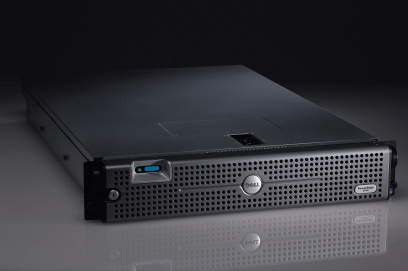

The Dell PowerEdge 2950 server is a 2U unit using Intel Xeon processors of various kinds: up to two quad-core Xeon 5300 series processors running at up to 2.66GHz (one of six Dell quad-core models currently available); up to two dual-core Intel Xeon 5100 series processors running at up to 3.0GHz; up to two dual-core low volt Xeon 5148 processors running at 2.33GHz; and up to two dual-core Xeon 5000 series processors running at up to 3.0GHz.
Available in three configurations with numerous permutations, the PowerEdge 2950 is one of Dell’s best sellers. But has it solidified the OEM’s hold on its two-socket sweet spot?
Although relatively new, PowerEdge 2950 is one of Dell’s best sellers.
“The Dell 2950 server represents Dell’s drive to keep two-socket configurations as the sweet spot in the x86 market,” says Gartner analyst John Enck. “Both IBM and HP are pressuring Dell on the 4-socket front, and Dell’s strength has been in the 2-socket market.
The HP ProLiant DL385 and the IBM system x3650, in particular, compete directly with the Dell 2950. So how is the Dell model better?
“These are all similar x86 servers so you see similar performance,” says Stori Waugh, senior manager of Dell PowerEdge Servers. “But we have the price/performance lead, as well as the benefit of our ninth-generation manageability features and behavioral spec.”
These ninth-generation (or 9G) features include a shared image for the Dell 1950, 2900 and 2950 servers that facilitates ease of management and deployment. As these servers are collectively the top sellers in the Dell server portfolio, IT managers can mix and match them rapidly. As they share the same image, less time is required for system updates.
The behavioral spec Waugh mentions is a definition of how Dell engineers design systems. Users
familiar with the 9G system, will not have to re-learn everything all over again for future refreshes. Reason: Cables will be lined up the same, and the basic architecture will remain very similar.
“This makes it easy to learn and deploy,” says Waugh. “If you know one system, you know them all.”
A programmable LCD allows admins replace complex code with text messages identifying the problem. Instead of 7438P, the operator might see a message reading, “HD failure, call Bob.”
I/O, hard drives and memory are expandable. On the disk side, for example, a maximum capacity (4.5 TB) is available using six 750GB SATA hard drives that spin at 7200 rpm. A variety of other SAS and SATA drive options are available, as well as the choice of 2.5 inch or 3.5 inch platters. The SAS drives spin at either 10,000 or 15,000 rpm.
Benchmarks and Comparisons
Dell touts the performance of its quad-core Xeons (8 processors) by comparing them with one of its own larger dual-core models. At half the price, the quad-core PowerEdge 2950 has slightly better performance than the dual-core Dell 6950.
Benchmark testing on its dual-core 2950’s also reveals high performance. The MMB3 benchmark, for example, is designed to mimic the workload requirements of the typical e-mail user. It addresses messaging throughput on Microsoft Exchange. On this test, the Dell PowerEdge 2950 dual-core 3 GHz version scored higher than the 4-processor HP ProLiant DL585, the 2-processor IBM System x3650 and the 2-processor HP DL385.
 |
| The Dell 2950 Source: Dell |
Similarly, the SPECjbb2005 benchmark showed the 2950 dual core in a favorable light. It achieved a score of 102,099 business operations per second, ahead of a couple of Fujitsu Primergy models for a new record on dual-core Java performance.
Waugh describes the 2950 as a general-purpose machine. It is equally suited for database applications, edge of network, infrastructure server, file/print and messaging. When asked for its sweet spot, she says it does particularly well with SAP, Exchange, SQL, Oracle and virtualization.
In terms of virtualization, the 2950 offers Intel Virtualization Technology (VT). This is built into the chipset to virtualize multiple workloads onto a physical server. It is said to increase utilization, and improve efficiency as well as return on investment.
Waugh also points out that Dell is the leading VMware reseller. She touts the 2950 as the perfect fit for virtual machines and server consolidation.
“The PowerEdge 2950 is an ideal platform for virtualization,” she says. “It has been designed to deliver the performance required to efficiently host multiple virtualized workloads.”
The server comes with a three-year warranty and has been generally available for several months. Although it comes in literally thousands of permutations, Dell simplified things by laying out three key configuration options.
“We have noticed three basic buying criteria: performance, energy or price sensitive,” says Waugh.
The low-cost base model has a single dual-core Intel Xeon 3 GHz processor, 1GB memory and an 80GB SATA 3.5-inch hard drive for a price of $1,699 (without an installed operating system).
The PowerEdge 2950 Energy Smart server uses one dual-core Xeon 5148 low-volt 2.33GHz processor. It has 4GB RAM and a 36B SAS drive, for a price of $3,298 (again, the operating system is not included). Energy Smart components also include Energy Smart power supplies, fans and BIOS.
“The 2950 Energy Smart model is a distinctly different machine from the regular 2950,” says Waugh.
The PowerEdge 2950 high-performance model comes with quad-core Xeon 5355 2.66GHz processors, 16GB RAM and three 146GB SAS (15,000 rpm) drives. It has a Dell Remote Access Card for remote management and RAID 5 capabilities. The price is $12,129.
Summary
The compact 2U form factor and high-performance processing power of the new PowerEdge 2950 enables customers to either replace older 2U servers with higher performing units or replace older, larger servers of similar speed to the PowerEdge 2950 to open rack space for expansion.
“By investing in the two-socket market supporting additional cores, larger hard drive capacities, and larger memory footprints, Dell hopes to keep two-socket configurations as king of the hill,” says Enck.
Dell PowerEdge 2950 Server Close Up
| Name | PowerEdge 2950 Server |
| Vendor | Dell |
| Platform | x86 |
| Footprint | 2U Rack-mountable chassis; 29.31″ (74.4cm) deep x 17.5″ (44.43cm) wide x 3.4″ (8.64cm) high; Rack Weight 50.71 lbs (23 Kg) maximum. |
| Processor Details | Up to two dual-core Intel Xeon Processors 5160 (up to 3.0 GHz) and a 1333 MHz front-side bus; or up to two quad-core Intel Xeon Processors E5320 (up to 1.86 GHz) with an up to 1066 MHz front-side bus |
| Hard Drives | Three hard drive base options delivering up to 4.5 TB of total capacity: Up to 4 x 3.5″ SAS (10K/15K) or SATA (7200) drives; Up to 8 x 2.5″ SAS HDs (10K); Up to six 3.5″ SAS (10K/15K) or SATA (7200) drives |
| Operating Systems | Windows Server 2003 R2 Standard Edition, Enterprise Edition and Web Edition; x64 Enterprise Edition and x64 Standard Edition; Windows Storage Server 2003 R2 Workgroup Edition, Standard Edition and Enterprise Edition; Red Hat Linux Enterprise v4, ES and ES EM64T; and SUSE Linux Enterprise Server 9 EM64T SP3 |
| Configuration Options | The low-cost base model has dual-core Intel Xeon 3 GHz processors, 1 GB memory and an 80GB SATA 3.5-inch hard drive The PowerEdge 2950 Energy Smart server uses the dual-core Xeon 5148 low volt 2.33GHz processor. It has 4 GB RAM, and a 36 GB SAS drive Energy Smart components also include Energy Smart power supplies, fans and BIOS. The PowerEdge 2950 high performance model comes with quad-core Xeon 5355 2.66GHz processors, 16 GB RAM and three 146 GB SAS (15,000 rpm) drives. It has A Dell Remote Access Card for remote management, as well as RAID 5 capabilities. Instead of the basic three years of support, it has 24-7 Silver Enterprise Support, which includes hardware and software assistance as well as on-site visits. |
| Availability | This server is currently available |
| Warranty | Three years |
Property of TechnologyAdvice. © 2025 TechnologyAdvice. All Rights Reserved
Advertiser Disclosure: Some of the products that appear on this site are from companies from which TechnologyAdvice receives compensation. This compensation may impact how and where products appear on this site including, for example, the order in which they appear. TechnologyAdvice does not include all companies or all types of products available in the marketplace.